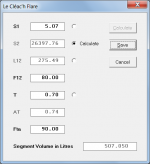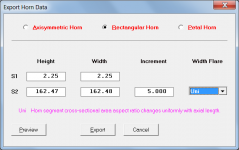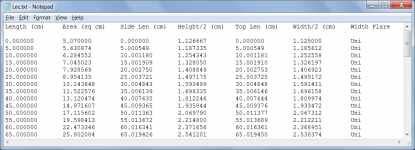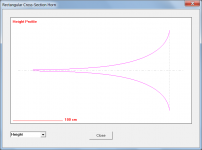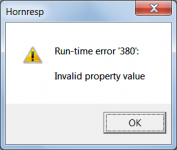Hi 3GGG,
A throat diameter of 25 mm seems rather small for a 80 Hz horn. Did you mean 25 cm?
Assuming that the horn data is exported using the Rectangular Horn option rather than the Petal Horn option, then for the attached Lec.txt file (with 25 mm throat diameter):
'Height/2' plotted against 'Side Len' gives the flat profile of one side of the horn, which can then be bent to make a horn mould.
'Height/2' plotted against 'Length' gives the standard elevation view of the horn, as shown in Attachment 4.
(Height/2 is the half-height - the distance either side of the centre-line)
See the Export Horn Data section in the Hornresp Help file for further details.
Kind regards,
David
I wish to build a 80 Hz Le Cleach Horn, terminating at 90 degrees with a throat diameter of 25mm.
A throat diameter of 25 mm seems rather small for a 80 Hz horn. Did you mean 25 cm?
It will be 4 sided, all sides equal in size. When I export the data does that give the coordinates for each panel, so they will flex into the correct shape? Or does it produce the coordinates of the final horn, as if it has been cut thru the central plane? Similar to the round horns. I hope this makes sense, basically i want to plot the exported coordinates, make a horn mould with bendy ply and bracing.
Assuming that the horn data is exported using the Rectangular Horn option rather than the Petal Horn option, then for the attached Lec.txt file (with 25 mm throat diameter):
'Height/2' plotted against 'Side Len' gives the flat profile of one side of the horn, which can then be bent to make a horn mould.
'Height/2' plotted against 'Length' gives the standard elevation view of the horn, as shown in Attachment 4.
(Height/2 is the half-height - the distance either side of the centre-line)
See the Export Horn Data section in the Hornresp Help file for further details.
Kind regards,
David
Attachments
That's terrible!
Did you loose much data?
Hi Mark,
I didn't lose any data - I took copies of everything before I initiated the System Recovery
Kind regards,
David
Great Thank you David. I did mean 25 mm, I am playing with some compression drivers and looking for a 100-150 Hz cut off to go above my 16 Hz bass horn I have.
Once again thank you for HornResp
Once again thank you for HornResp
Hi 3GGG,
A throat diameter of 25 mm seems rather small for a 80 Hz horn. Did you mean 25 cm?
Assuming that the horn data is exported using the Rectangular Horn option rather than the Petal Horn option, then for the attached Lec.txt file (with 25 mm throat diameter):
'Height/2' plotted against 'Side Len' gives the flat profile of one side of the horn, which can then be bent to make a horn mould.
'Height/2' plotted against 'Length' gives the standard elevation view of the horn, as shown in Attachment 4.
(Height/2 is the half-height - the distance either side of the centre-line)
See the Export Horn Data section in the Hornresp Help file for further details.
Kind regards,
David
Great Thank you David. I did mean 25 mm, I am playing with some compression drivers and looking for a 100-150 Hz cut off to go above my 16 Hz bass horn I have.
Once again thank you for HornResp
100 to 150 on a compression driver!
Are you planning on a three way system?
Because going that low on a compression driver is a very tall task to ask for.
Voice range is roughly 300 hertz to 4000 hertz.
100 is a very tough request. To keep the same SPL level you need to increase the diaphragm displacement by a factor of four times every time you drop an octave, or one half the previous level.
1024 - 512 hetrz is an octave drop.
100 is a very tough request. To keep the same SPL level you need to increase the diaphragm displacement by a factor of four times every time you drop an octave, or one half the previous level.
1024 - 512 hetrz is an octave drop.
100-150 Hz..........going that low on a compression driver is a very tall task to ask for.
Indeed it does, the WE 15 horn uses the 1" exit 555 driver that covers the entire vocal range and there's replicas available for both, though the driver isn't an exact replica and if you have to ask what the prices are, you probably can't afford either.
FWIW, I did 300 Hz/2nd order XO using dual 1" Altec 802 drivers [one low passed] on a ~212 Hz DIY horn and Altec made some four driver adapters for either extreme SPL @ 300 Hz or 150 Hz customs, so multiples is the way to go.
GM
Hornresp Update 3700-150301
Hi Everyone,
I found a bug while checking the operation of the Filter Wizard (in response to Jack's posts #5272 and #5275). The sequence of actions leading to the generation of the fatal error is as follows:
1. Import room gain profile
2. Calculate default record results
3. Include room gain
4. Open Filter Wizard
5. Select Filter Phase output option
6. Close Filter Wizard
7. Re-open Filter Wizard
Error Message:
Run-time error '380':
Invalid property value
This bug has now been fixed.
Kind regards,
David
Hi Everyone,
I found a bug while checking the operation of the Filter Wizard (in response to Jack's posts #5272 and #5275). The sequence of actions leading to the generation of the fatal error is as follows:
1. Import room gain profile
2. Calculate default record results
3. Include room gain
4. Open Filter Wizard
5. Select Filter Phase output option
6. Close Filter Wizard
7. Re-open Filter Wizard
Error Message:
Run-time error '380':
Invalid property value
This bug has now been fixed.
Kind regards,
David
Attachments
I used the Goto SG-570 down to 200Hz on a big straight exponential horn. I think it was a 150Hz horn (I didn't design or build it). Sounded great. I never took max output / distortion measurements of it (afraid to break it - it wasn't mine), but it would go loud with no noticeable distortion. I'm contemplating something similar with my own setup, but without the Goto driver. Whenever I get around to finishing that, I'll have tons of measurements.
Contraindicated
The air-flow resistance of a 25mm (1/10") dia. orifice is to high to pass the volume velocity needed to deliver any reasonable SPL at the lower bound of the frequencies of interest. Typically a 3" to 4" dia. throat should be used.
Note that the phase plug area will have a bounding dia. much larger the 25mm.
Regards,
WHG
Hi David
I wish to build a 80 Hz Le Cleach Horn, terminating at 90 degrees with a throat diameter of 25mm. It will be 4 sided, all sides equal in size. When I export the data does that give the coordinates for each panel, so they will flex into the correct shape? Or does it produce the coordinates of the final horn, as if it has been cut thru the central plane? Similar to the round horns. I hope this makes sense, basically i want to plot the exported coordinates, make a horn mould with bendy ply and bracing.
The air-flow resistance of a 25mm (1/10") dia. orifice is to high to pass the volume velocity needed to deliver any reasonable SPL at the lower bound of the frequencies of interest. Typically a 3" to 4" dia. throat should be used.
Note that the phase plug area will have a bounding dia. much larger the 25mm.
Regards,
WHG
The air-flow resistance of a 25mm (1/10") dia. orifice is to high to pass the volume velocity needed to deliver any reasonable SPL at the lower bound of the frequencies of interest. Typically a 3" to 4" dia. throat should be used.
Note that the phase plug area will have a bounding dia. much larger the 25mm.
Regards,
WHG
At 120dB you will see about 10m/s peak at 100Hz for a 25mm diameter throat, rather large 80Hz horn in 2pi loading according to Hornresp. That seems fine to me for home use, although it's obviously a pretty extreme setup.
Ridiculous!
1) Volume-velocity is in m^3/s.
2) Velocity [c] = [Vv]/[So] (m/sec)
So=[pi]*([Do]^2)/4 - Area of Orifice (m^2)
3) This is not the same as implementing a high compression ratio at the phase plug [St]. In practice, as the lower frequency bound is lowered, [St] at the phase plug is increased.
I fail to see any benefit to be gained by reducing horn throat diameter to 25 mm, other than to unnecessarily impair the performance of the extremely expensive compression driver that is required.
WHG
At 120dB you will see about 10m/s peak at 100Hz for a 25mm diameter throat, rather large 80Hz horn in 2pi loading according to Hornresp. That seems fine to me for home use, although it's obviously a pretty extreme setup.
1) Volume-velocity is in m^3/s.
2) Velocity [c] = [Vv]/[So] (m/sec)
So=[pi]*([Do]^2)/4 - Area of Orifice (m^2)
3) This is not the same as implementing a high compression ratio at the phase plug [St]. In practice, as the lower frequency bound is lowered, [St] at the phase plug is increased.
I fail to see any benefit to be gained by reducing horn throat diameter to 25 mm, other than to unnecessarily impair the performance of the extremely expensive compression driver that is required.
WHG
At 120dB you will see about 10m/s peak at 100Hz for a 25mm diameter throat
Giving a peak volume velocity of 0.005 m^3/s or 4909 cm^3/s.
I really appreciate the particle velocity calculations. Before we had a hunch that this was not a good idea, but now we have confirmation as to a fairly accurate calculation of the design factors.
And it all started with the sliders and the horn wizard. From there David has really widened out the programs capabilities.
And it all started with the sliders and the horn wizard. From there David has really widened out the programs capabilities.
Size Matters
Do not water your lawn with a piece of IV tubing, if you expect to get finished any time soon, unless of course you have a yard the size of a postage stamp.
There is a good reason why the hose on a fire truck is so large in diameter.
Regards,
Bill ;-)
Giving a peak volume velocity of 0.005 m^3/s or 4909 cm^3/s.
Do not water your lawn with a piece of IV tubing, if you expect to get finished any time soon, unless of course you have a yard the size of a postage stamp.
There is a good reason why the hose on a fire truck is so large in diameter.
Regards,
Bill ;-)
- Home
- Loudspeakers
- Subwoofers
- Hornresp
